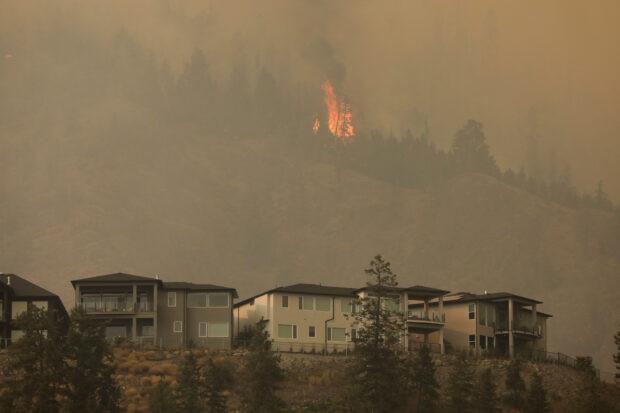
The McDougall Creek wildfire burns outside the Okanagan community of West Kelowna, British Columbia, Canada August 18, 2023. (REUTERS)
Wildfires that ravaged interiors of British Columbia for the past four days showed some signs of easing on Sunday, giving hope to firefighters who have been at the forefront of an “epic” battle, but authorities warn of a long road to recovery.
More than 35,000 people have been driven out of their homes in the western Canadian province, forcing the federal government to deploy military, and the province to declare a state of emergency.
British Columbia also banned non-essential travel to ensure adequate accommodation is available to people displaced by the fires.
The Pacific coast province could get some rains this week from the moisture of Tropical Storm Hilary, which made its historic arrival in California on Sunday, bringing some relief to the province which is in the grip of a severe drought.
Jason Brolund, Fire Chief of West Kelowna, one of the worst affected areas by the fires, said conditions have improved which is helping firefighters to put “boots on the ground.”
“We haven’t been challenged with extraordinary fire behavior. We are dealing with things like we are used to seeing. However, we are dealing with them on an epic scale,” Brolund told the Canadian Broadcasting Corp.
Still, he warned of difficult days ahead.
Forest fires are not uncommon in Canada but the spread of blazes and disruptions underscore the severity of its worst wildfire season yet, which some experts have blamed on climate change.
About 140,000 square km (54,054 square miles) of land, roughly the size of New York state, have been scorched nationwide, with smoky haze extending as far as the U.S. East Coast. Government officials project that the fire season could stretch into autumn because of widespread drought-like conditions.
About 2,000 km to the north, a wildfire burning out of control in Yellowknife, the capital of Northwest Territories (NWT), has turned the remote interior city into a smoky, ghost town with almost all the of its 20,000 residents evacuated.
Some 400 Canadian armed forces personnel are helping the NWT government to deal with the fire, which remains “fluid”, a statement issued by National Defense on Sunday said. Fires continue to be about 15 km from the city and it was unclear when it will reach the city.
NWT officials told reporters on Sunday there is no timeline yet to bring back the evacuated residents to their homes in Yellowknife unless it is safe to do so.